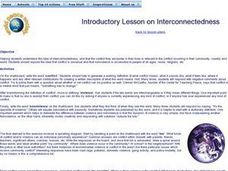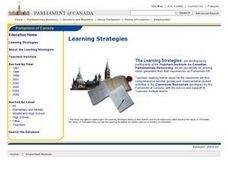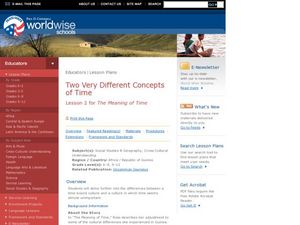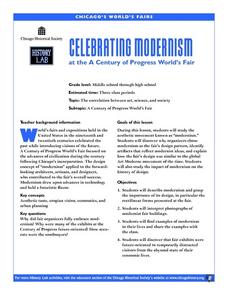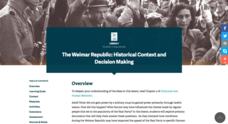Curated OER
Adding to the Picture: The 1963 March on Washington
Who do your scholars imagine when they think about the civil rights movement? If only a few faces come to mind, this lesson will expand their concepts of the movement's leaders. Learners examine an image of the 1963 March on Washington,...
Curated OER
Introductory Lesson on Interconnectedness
Students are introduced to the concept of interconnectedness and make connections regarding conflict in their community, country, and the world. For this interconnectedness lesson plan, students define the word conflict and what that...
Curated OER
Understanding Daoism through study of the Daodejing
Students work in groups and study Daodejing. They describe how Monkey's behavior (from the Monkey Stories) is governed by the Yang and the Yin powers.
Curated OER
A Case Study: My Friend Brian
Eighth graders study a case study in which a Korean student, Brian, is beaten and accused of being a homosexual.
Curated OER
The Foot Soldier Project for Civil Rights Studies
Students investigate the concept of foot soldiers with oral history. They are provided with primary and secondary resources. Students differentiate the terms of oral history versus the written record of history. They have class...
Curated OER
The Social Distribution of Crime
Students explore crime within society and the factors that affect it. In this lesson about sociology and crime, students are introduced to key ideas concerning crime and society. Students develop an understanding of factors in society...
Curated OER
Technology: Mass Production and Standardization
Students explore standardization and mass production by creating verbal visual vocabulary tables. They discover how industrial inventions increase profits for businesses. Students create three-tiered definition concept trails using...
Curated OER
A Visual History: Industry, Society, and Social Mobility in Hartford
Eleventh graders examine the industrialization of Hartford. In this American History lesson, 11th graders analyze pictures in Hartford. Students participate in a gallery walk of artifacts.
Curated OER
Economic Concepts and Definitions
Third graders identify producers and consumers in SE Utah and Four-Corners communities. They identify the factors that determine economic development and name some occupations in their community. They show and share their graphic...
Curated OER
Political and Social Origins of the Civil War
Middle schoolers examine the difference in politics in the North and South during the Civil War. Using that information, they discuss how politics and ideologies led to the war. They explain the causes and effects of the war and evaluate...
Curated OER
Social Life in the 1950's and Domestic Politics and Policy
Eleventh graders examine the cultural mood and politics of the 1950's in the United States. They read a section of their text and take notes, view a clip of the movie "Pleasantville" and discuss societal roles in the 1950's, and listen...
Curated OER
Social Studies: Renaissance
Students explore Renaissance architecture. In this Renaissance lesson, students view a slideshow featuring architecture of the era and then discuss the math skills used to the build the structures. Student build their own replicas of...
Curated OER
Two Very Different Concepts of Time
Students delve further into the differences between a time-bound culture and a culture in which time seems almost unimportant. They answer the questions: How do people of different cultures view time differently? What can we learn from...
Curated OER
Lesson for Core Concept #7: Differing Expectations
Students investigate how American colonists felt they would be impacted by conflict with the British. In this colonial America lesson, students examine the Declaration of Independence, papers from the Committees of Correspondence, and...
Curated OER
Environment, Technology, and Culture of the Chumash People
Students develop an understanding of the interrelatedness of technology, culture, and environment as illustrated by the Chumash culture. They research the tribe and complete a table for the Chumash people describing their environment,...
Curated OER
Geo-Magazine
Divide your geography class into groups and have each research an assigned region. The result of this project is a regional magazine that addresses the five themes of geography. Many valuable resource links are embedded into the page...
Curated OER
Celebrating Modernism at the A Century of Progress World's Fair
Students examine aesthetic movement known as modernism, discover why organizers chose modernism as World Fair's design pattern, interpret photographs of modernist fair buildings and identify artifacts that reflect modernist ideas, and...
Constitutional Rights Foundation
Educating About Immigration The DREAM Act
Group members role play state legislators, supporters of and opponents to the The DREAM Act (Development, Relief, and Education for Alien Minors). After listening to the arguments put forth for and against the immigration legislation,...
Curated OER
Living in the Desert
Conduct an investigation on the plants used by the Hohokam tribe. To survive in the harsh desert environment the Hohokam used many natural resources. Learners read, research, map, and graph multiple aspects of Hohokam plant use as a...
Curated OER
Sneetches: Diversity of Learners
For Learners wanting to practice verbal/linguistic intelligence, any Dr. Seuss book is an excellent text for examining rhyming words. They explore words that rhyme with bully, mean, snooty, nasty, tease, harass, hurt.
PBS
A Veterans Day Thank You Note
This Veterans Day inspire scholars to say thank you to a veteran. Here, learners discover key details about a specific war using an interactive timeline, and then write a thank you letter offering their gratitude to someone who risked...
Curated OER
The Emergence and Evolution of the Cuneiform Writing System in Ancient Mesopotamia
Middle schoolers explore the parallel development and increasing complexity of writing and the growth of civilization in the Tigris and Euphrates valleys in ancient Mesopotamia.
Curated OER
Understanding Stereotypes
Pupils confront age-related stereotypes, explore how stereotyping impacts their lives, and discuss how they can make changes to reduce over-generalizations, unfair assumptions, and critical judgments about people groups. They use a...
Facing History and Ourselves
Us and Them: Confronting Labels and Lies
Stereotyping and discrimination based on religion catalyze many atrocities in the world. Explain the awful treatment of Jews and the lies Nazis spread by using an informative yet sensitive resource. Learners participate in a warm-up and...



